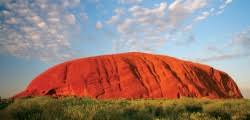In the country of antipodes (part 2)
 In the tropical rainforests on the west coast of Tasmania, places are still preserved where the human foot has never stepped. Therefore, part of the island was included in the list of “World Heritage Sites”. In the late 1980s, a series of stamps was released in Australia dedicated to representatives of the local fauna that are facing extinction. Controversial is the brand with the image of the famous Tasmanian tiger, which is sometimes called the marsupial wolf.
In the tropical rainforests on the west coast of Tasmania, places are still preserved where the human foot has never stepped. Therefore, part of the island was included in the list of “World Heritage Sites”. In the late 1980s, a series of stamps was released in Australia dedicated to representatives of the local fauna that are facing extinction. Controversial is the brand with the image of the famous Tasmanian tiger, which is sometimes called the marsupial wolf.
Tilacin, or the Tasmanian marsupial wolf, it is a zebra-shaped possum, it is also a “Tasmanian tiger” – one of those rare animals that a person surrounds with a halo of mystery and seeks to get at any cost. True, the current interest in this beast is somewhat late, since it is most likely posthumous. As far as is known, the last representative of this type of the largest marsupial cats (up to 90 centimeters in length) died in the Zoo in Hobart in 1933.
Since then, in Tasmania, sometimes rumors arose that looked like legends that someone somewhere, they say, saw this animal alive. But there is no documentary evidence. As it often happens, unfortunately, happens, the Tasmanian wolf was taken under the protection of law in Australia only in 1936 – three years after it officially registered the disappearance of the whole species. Nowadays, scientists would give a lot to get if not a couple of live exhibits, then at least stuffed animals or skins of these animals.
The interest of the scientific community is spurred by the periodic appearance of reports that the Tasmanian wolf allegedly caught the eye of individuals. In order to verify this information, the Australian branch of the International Fund for Wildlife Lovers organized two expeditions. Scientists literally combed the island, armed with cameras and movie cameras that work in automatic mode and are able to shoot in the dark using an infrared device. This equipment was left, disguised, in the places where animals were likely to appear for a month or more.
The results so far obtained have not put an end to doubts. Some of the cameras located in 17 possible habitats of tilacin captured nine species of local animals, including rare ones, on 420 photographs. However, traces of tilacin have not yet been found. Nevertheless, the search for the mysterious animal continues.
But traces of Australian Aborigines in Tasmania are no longer being sought – they have been plundered before the root of the Tasmanian wolf. In 1986, archaeologists discovered 15 cave paintings painted in red in one of the caves on the island. Scientists believe that they were made by human hands 14 thousand years ago. If this is confirmed, the found cave paintings will be attributed to the oldest of the currently known.
Once again about suicide whales
There are still reports in the press that whales are being thrown on the coast of the Tasman Sea. In the mid-80s of the last century, a large-scale drama broke out here: more than one hundred of these giant animals committed collective suicide. Around the same years, the authoritative American ichthyologist Lyall Watson, who studied the marine environment, put forward a hypothesis that shed new light on one of the unsolved mysteries of nature. Previously, the most widespread in the scientific community version was that whales were thrown ashore due to a loss of orientation in shallow water, that is, they simply go astray.
This explanation, says Professor Watson, does not take into account the extreme sensitivity of the sound location system with which these animals are oriented in space. It is hard to imagine that they are able to g
A similar case was reported from New Zealand. The only way to stop the massive ejection of whales ashore, Lyall Watson believes, is cruel, but effective: you must kill the first animal that appeared on land, and this can save the rest. The researcher believes that the herd will help a fellow victim in distress as long as he is alive, even if waiting threatens death to all whales.
In humans, this is called selflessness. And whales do without words …
How the kangaroos got their name
Nowhere on earth can one meet such a variety of marsupial animals as in Australia. There are 250 species of them, 170 of which – marsupial badgers, kangaroos, wombats – are endemic, live only in Australia. Judging by the fossil remains, they appeared here 25 million years ago. The largest marsupials are gray and red kangaroos. An adult male, called a boomer, is about 2 meters tall, weighs about 90 kilograms. It runs 12-15 miles per hour, and if necessary increases speed to 40 miles. A gray kangaroo is also distinguished by a jump height of up to 3.3 meters, and a red kangaroo with a jump length of up to 13.5 meters. Moreover, neither one nor the other do not use any dope. A good example, by the way …
There are few animals on earth that arouse such curiosity as a kangaroo. Proud posture, agile front legs, slender and elongated hind legs, a prancing mode of movement, which, in fact, is his famous gait, and many other special qualities distinguish the kangaroo from the animal kingdom.
With his front legs he brings beauty with human agility – he brushes his coat, and if necessary, defends himself deftly, like a boxer. But the real strength of this outlandish animal is given by the extended hind legs. On a walk, going from slow running in four to racing in two, the kangaroo becomes graceful, like a ballerina. He runs as he flies, is in the air much longer than on earth. The experiments showed that at high speed on two legs no more energy is spent than at low speed on four.
Shy and even shy by nature, the kangaroo shows a lot of strength and resourcefulness in the battle with the enemy. He has his own arsenal of self-defense techniques. Australians usually hunt kangaroos with trained dogs. In a hopeless situation, a dead-end animal stands on the tip of its powerful tail and hits the stalker with the dagger-like claws of its hind legs. If there is water nearby, the kangaroo uses even more unexpected tactics. He takes a deep breath, suddenly grabs the attacking dog and dives with it into the water. And he does this until the dog dies. And although she is a tried and tested friend of man, sympathy in this situation, apparently, should nevertheless be a kangaroo, who is forced to defend itself …
Their life is hard. It feeds, grows and protects the mother. After four or five weeks of pregnancy (depending on the species), the female usually has a single offspring. Before giving birth, the female licks her bag on her stomach, puts it in order. It is amazing how a blind newborn baby finds a path among her thick maternal fur to her bag, where, instinct tells, there are nipples with warm milk.
A bean-sized kangaroo will be born, and grows taller than a person. But this is not the most surprising. The most surprising thing is that a pregnant female can, if necessary, delay the birth: in this case, a kangaroo, ready to be born, as if freezes in her womb, does not appear until all the conditions for its development are ready.
It’s not easy to see a kangaroo, even a large one. He grazes at night, sleeps during the day, hiding in tall grass, in a bush, in the thick of eucalyptus trees. An eagle, a python, a wild dingo dog – everyone preys on kangaroos, and a man kills an adult kangaroo, as we remember. But his worst enemy is drought. When streams and rivers dry up, grass and bushes dry up, all kangaroos die, and adults cease to interbreed.
Fortunately, nature has endowed this animal with tolerance to feed: no one eats what a kangaroo can eat. One day a naturalist caught a kangaroo to take a picture of him and let him go. He was so sad that the scientist put up a cardboard box with salad and fruit in front of him to lift his spirits. The kid gratefully accepted this gift, but disposed of it in his own way: he refused the salad and fruits and ate a box.
et lost in their native element. This hypothesis contradicts the well-known facts that whales that were able to tow aground back into the sea, that is, as if to put on the right road, will soon return to their brothers in distress.
So, among the 30 whales that landed on the coast of the island near Florida, one large male was badly wounded. The others crowded around him closely, as if trying to lift him and keep him afloat. The ebbs and flows in this area are weak, so that any of the healthy whales could swim without problems into the open sea. However, none of them did this. And when the scientist who watched this drama, using a breathing tube for scuba diving, made sounds imitating the screams of a whale that got into trouble, one of the animals separated from the herd, slipped under it and carried it ashore. The whales sailed into the sea only three days later, when their wounded comrade died.




